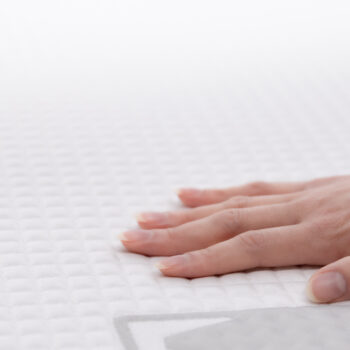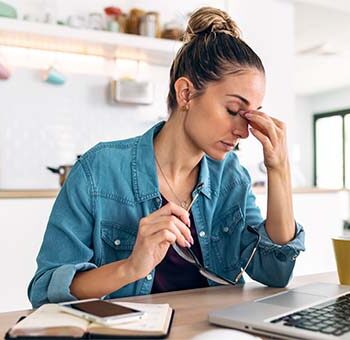
5 More Causes of Sleep Loss and What to Do About Them (2024)
We are owned and operated by GoodMorning.com. We hire 3rd-party engineers and use public data to rate mattresses on over 30 criteria that we believe are important. Brands we own—Douglas, Juno, Octave, Logan & Cove, and Novosbed—are reviewed and advertised where indicated. Views expressed here are our opinions only. Full details.
There simply wasn’t enough room in our previous blog post to cover all the common reasons people lose sleep and what to do about them. So here’s another round of useful tips from experts on how to regulate your sleep more efficiently.
Anxiety and racing thoughts
We’re not referring to psychiatric conditions like generalized anxiety disorder or ADHD here, which do cause people to lose sleep. Diagnoses such as these are for physicians and psychiatrists. Instead, we’re talking about the kind of anxiety and racing thoughts that affect most people from time to time. Everybody knows how a rough day, a financial struggle, or an argument with a loved one can cause distress that clouds our thoughts. It’s very typical to lose sleep over such episodes.
What’s the solution:
During those nights when you are plagued with “what if?” questions or feelings of regret and dread, there are some useful, holistic techniques to ensure you don’t lose too much sleep. According to experts at the Harvard Medical School, “meditation, guided imagery, deep breathing exercises, and progressive muscle relaxation (alternately tensing and releasing muscles) can counter anxiety and racing thoughts.”
Sleeping position
Back and stomach sleepers are more likely to experience problems that cause them to lose sleep. Back sleepers are infamous for snoring. And stomach sleepers, with their twisted necks and unorthodox spinal alignment, can experience the kind of muscle pain that prevents the brain from enjoying deep sleep. Any sleeping position that inhibits smooth breathing or leads to (even slight) muscle pain is a leading cause for losing sleep.
What’s the solution:
Embrace side sleeping. It’s that simple. Side sleepers get the best sleep. If side sleeping feels weird, invest in a full-length body pillow to help your body adjust to the habit. This will also prevent you from winding up in the fetal position, which can also inhibit smooth breathing. A side-sleeper with straight legs and spine is well positioned for a great night’s sleep.
Not exercising at any time during the day
Five years ago, the advice would have been not to exercise close to bedtime. Without substantial evidence to back the assertion, old sleep hygiene guides used to say that nighttime activity revved the body up too much, thus inhibiting sleep. But the times they are a-changin’. A scientific study has found that exercise at night was no worse for sleep than exercising in the morning. The important thing is that exercising, in general, helps folks sleep.
What’s the solution:
Give your body a reason to feel tired at bedtime. Regular exercise each day will help you develop a healthy sleep pattern, especially if you work a sedentary job. There is no evidence to suggest that nighttime exercise is better than daytime exercise. But the burgeoning availability of late night gyms has proliferated the number of twilight keep-fit aficionados. So you may be able to find time for exercise, even with a demanding schedule. And, if you find that exercising at night fires you up too much to sleep well, switch to a daytime workout. There is no ideal hour for all people to get their exercise.
Caffeine
Nothing beats a cup of joe in the morning, right? For some, caffeine is essential not only to their morning routine but also to their afternoons and evenings. Caffeine is the mild stimulant the world loves to consume. Widely available in coffee, but also present in chocolate, energy drinks, sodas, black and green tea, and even ice cream, caffeine consumption is all around us. But it keeps us awake at night.
What’s the solution:
It’s trite to say: “cut out caffeine after 2 pm,” or “cut it out altogether.” We all know that drinking caffeine late in the day is detrimental to sleeping well. What’s more interesting is why we don’t listen to our good advice on this topic.
If you find yourself using caffeine as a stimulant to get through afternoon or evening tasks, you may be prone to caffeine expectancy. Essentially, caffeine expectancy means that your brain and body have become used to performing better with caffeine in your system. You do your best with caffeine in your veins. But it’s a false economy. It’s likely you would perform even better in the afternoons and evenings if you slept better every night and did not depend upon caffeine. So, why not start weaning yourself off the caffeine? A better night’s sleep awaits you.
Your partner
Partner disturbance is a major contributor to lost sleep hours around the world. If your partner tosses and turns all night, or even snores, a lasting solution to your restless nights is called for. A common and increasingly popular solution is what The Globe and Mail calls a ”night divorce.” In short, this means sleeping in separate beds, or even different rooms. It can sound drastic, but the negative implications of sleeping poorly night after night have pushed many couples in this direction. And the results are often great for the relationship. The payoff includes improved moods the next morning, and less resentment towards the snoring or toss-and-turning sleeper.
What’s the solution:
Well, a “night divorce” may be the answer. But there are other solutions, especially if the partner disturbance you are experiencing is moderate. There are plenty of ways to tackle snoring. Your partner could change sleep position or their pillow. Staying hydrated and avoiding alcohol at night are also good ways to reduce snoring. Likewise, for chronic snorers, the use of CPAP machines is now widespread.
And for the partner that tosses and turns, consider investing in a mattress with excellent motion isolation. Memory foam mattresses have a better reputation for motion isolation than innerspring mattresses. But the innerspring industry has upped its game in recent years to improve motion isolation, especially in hybrid mattresses.
Related article: Can’t Sleep? Try These 7 Simple Techniques


